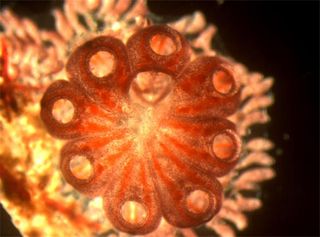Sea Squirt Regrows Entire Body from One Blood Vessel

Our closest invertebrate relative, the humble sea squirt, can regenerate its entire body from just tiny blood vessel fragments, scientists now report.
The entire regeneration process, which in part resembles the early stages of embryonic development, can produce an adult sea squirt in as little as a week.
- Video: Skimming the Seabed
The finding could illuminate not only the evolutionary origins of regeneration in all organisms, but also subsequent changes to it during vertebrate evolution.
Vertebrates (animals with backbones) such as salamanders are capable of regenerating limbs or tails, and even humans are capable of regenerating portions of skin, lungs and livers.
"However, in general, the more complex the animal, the lower the regeneration abilities are, relatively," biologist Ram Reshef at Technion Israel Institute of Technology in Haifa explained. "No vertebrate could regenerate their whole bodies if you cut them in two."
The ability to regenerate a whole body from a fragment is typically restricted to less complex invertebrates, such as sponges, worms and jellyfish. Nonetheless, Reshef and his colleagues, including biologist Yuval Rinkevich, chose to look at the sea squirt Botrylloides leachi [image], a more complex invertebrate, by carefully peeling off colonies from underneath stones in shallow waters along the Mediterranean coast of Israel.
The scientists found that "massive regeneration is not just confined to low complexity animals, but rather can take place in highly evolved animals," Reshef told LiveScience.
Sign up for the Live Science daily newsletter now
Get the world’s most fascinating discoveries delivered straight to your inbox.
Each colony is composed of up to thousands of genetically identical individuals, each two to three millimeters long and embedded in a gelatinous matrix. A network of blood vessels connects all modules within a colony.
The scientists removed fragments of blood vessels from the colonies and placed them on microscope slides for investigation. Each roughly one-millimeter-long fragment contained one or more ampullae, which are the pear-shaped endpoints of the vessels, as well as 100 to 300 blood cells.
Of 95 fragments, 80 regenerated an entire functional adult within one to three weeks.
The whole body regeneration process that the scientists witnessed proved unlike any recorded so far. "When less complex groups regenerate their bodies, they do so through what we call a blastema, which is a kind of tissue that forms right at the place where you want to regenerate an organ or body," Reshef said.
In contrast, the sea squirts did not employ blastemas. Instead, regeneration began from dozens of tiny compartments loaded with stem cells, which the researchers dubbed regeneration niches. "In mammals, many adult organs and tissues contain specific stem cells that are involved in repair and some restricted regeneration abilities," Reshef said.
The regeneration niches helped form a hollow sphere that organized into a thin and thick layer on opposite sites, very similar to early stages of embryonic development. As cells proliferated, this sphere folded over and over again, developing chambers and organs, with the end result being adults capable of sexual reproduction.
While the stem cells the researchers looked at are much like stem cells in adult mammals that give rise to our tissues and organs, "the huge difference is that they culminate in an entire organism," Reshef said. The most important implication of their finding is the possibility that vertebrate adult tissue stem cells may exhibit the same capabilities to generate any cell in the body, he added.
Reshef and his colleagues are currently teasing apart the molecular mechanisms by which the sea squirt accomplishes its whole body regeneration and to compare that process with similar mechanisms in other invertebrates and vertebrates. "We speculate that vertebrates altered or suppressed parts or all of this ability," Reshef said.
The scientists detailed their latest findings March 6 in the journal PLoS Biology.
- Rich Life Under the Sea
- Image Gallery: Small Sea Monsters
- Image Gallery: Underwater Explorers
- Scientists Turn Stem Cells Into Neurons
- Behind the Controversy: How Evolution Works

